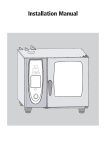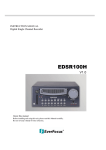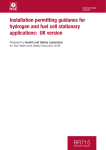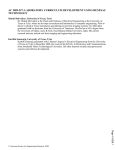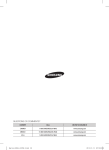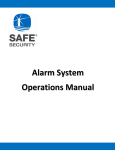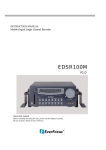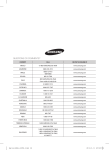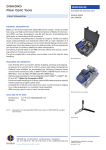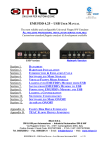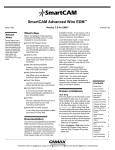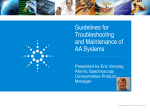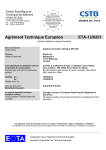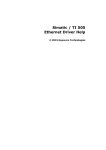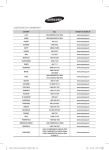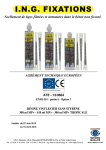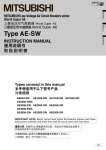Download CE guide EDM 072015
Transcript
The European Association of the Machine Tool Industries Where manufacturing begins Guidelines for CE marking on electro-discharge machines 07/2015 Objectives of the guide Machinery and equipment which are bound by specific European directives cannot be placed on the single market unless they bear CE marking. CE marking affixed on a product indicates that the product complies with all relevant essential requirements (e.g. health and safety requirements) of the applicable directive(s). However, market surveillance in the EU often fails to prevent the entry of noncompliant imported machinery into the internal market and/or the circulation of non-compliant European machinery in Europe. Machines not meeting essential health and safety standards threaten health and safety in the workplace and put workers’ lives in danger. Moreover, manufacturers and suppliers who do not comply with European regulations benefit from reduced production costs and gain an unfair comparative advantage in the market. This distorts competition and undermines the competitiveness of European manufacturers who invest a significant amount of their resources in the development of products with high safety standards meeting European regulations. Cases of non-compliance may occur due to lack of information (or misinformation) of producers who fail to meet the relevant standards or due to deliberate infringements by producers who want to unfairly cut their production costs. The shortcomings of the systems need to be urgently addressed. Firstly, better communication towards economic operators on EU regulations, standards and conformity assessment procedures is required in order to improve ex-ante mechanisms designed to ensure compliance with EU law. Secondly, exposit mechanisms (market surveillance) should be strengthened. CECIMO believes that effective market surveillance requires close cooperation between economic operators, customs authorities and surveillance bodies. In line with this view, the present guide aims to contribute to the ongoing work led by the European Commission to enhance market surveillance in the internal market, under the New Legislative Framework. We hope that this guide will be a valuable source of information for manufacturers, sellers and users of machine tools as well as customs authorities to detect noncompliant products in the internal market. Better functioning market surveillance will contribute to creating a more secure working environment for workers and a more competitive European Industry. 3 | Guidelines for CE Marking on electro-discharge machines | 07/2015 Contents Objectives of the guide ..................................................................................................... 3 Verifying the validity of the declaration of conformity ................................................. 5 EU directives which apply to electro-discharge machines The EC Declaration of Conformity CE marking & warning signs .......................................................................................... 8 Is the official CE marking used? Where can the CE marking be placed? Which items of pressure equipment might need CE marking? Who can affix the CE marking? What should be included on the nameplate? In which language should the instructions be? In which language should the technical file be? What should the machine not bear? What about the obligations for the importer/distributor? Are the CE marked electro-discharge machines tested and approved by the authorities? Which warnings should be included on electro-discharge machines? Verifying the conformity of the machine ........................................................................ 12 Accompanying instructions.............................................................................................. 17 Transportation information...............................................................................................18 4 | Guidelines for CE Marking on electro-discharge machines | 07/2015 Verifying the validity of the declaration of conformity The declaration of conformity shows the EU directives which apply to electrodischarge machines (EDM) and to which the equipment complies with, must include at least the following: (voluntarily) refer to the harmonized standards used for the conformity assessment, such as: EU directives which apply to electrodischarge machine • EN ISO 28881:2013/AC:2013 The machine should comply with all the applicable directives and these should be mentioned in the declaration of conformity. The infringement of a single directive results in the non-conformity of the machine to EC requirements. Therefore, it is of utmost importance to specify which directives apply to each machine and to conduct a declaration of conformity that includes all the necessary information. Directives which apply to electro-discharge machines include: • Machinery Directive (2006/42/EC) • Low Voltage Directive (2006/95/EC)1 • Electromagnetic Compatibility Directive (2004/108/EC)2 Additionally the manufacturer should • EN ISO 28881:2013 Machine tools – Safety – Electro-discharge machines 3,4 • EN ISO 12100:2011 Safety of machinery – General principles for design – Risk assessment and risk reduction The EC Declaration of Conformity If the machine is CE marked and put on the market, the Declaration of Conformity should accompany the machine and should be presented to market surveillance authorities. The EC Declaration of conformity must be provided in the language of the country where the machine is to be used. It is the responsibility of the manufacturer or his authorized representative to draw up and sign an ‘EC declaration of conformity’ (DoC) proving that the product meets the requirements. The DoC must include: • Business name and full address of the manufacturer and, where appropriate, 1 Electrical machinery that is not in any of the categories listed in Article 1 (2) (k) of the Machinery Directive (and that is not concerned by one of the other exclusions) is in the scope of the Machinery Directive. When such machinery has an electrical supply within the voltage limits of the Low Voltage Directive (between 50 and 1000 V for alternating current or between 75 and 1500 V for direct current), it must fulfill the safety objectives of the Low Voltage Directive. However, in this case, the manufacturer’s EC Declaration of Conformity should not refer to the Low Voltage Directive. On the other hand, low voltage electrical equipment placed on the market independently for incorporation into machinery is subject to the Low Voltage Directive as such Machinery Directive guide p.52 2 Ian Fraser, Guide to the Application of the Machinery Directive: The EMCD applies to machinery that contains electrical or electronic parts that may generate or be affected by electromagnetic disturbance. The EMCD covers aspects of electromagnetic compatibility related to the functioning of machinery. However, the MD covers the immunity of machinery with respect to safety-related electromagnetic disturbance, whether transmitted by radiation or by wire. 3 Type-C stabdard as defined in ISO 12100:2010 4 It supersedes EN 12957:2001+A1:2009 5 | Guidelines for CE Marking on electro-discharge machines | 07/2015 his authorised representative (the business name and full address of the manufacturer should be the same as those typed on the machine. The manufacturer is not obliged to have an authorized representative, although should he choose to do so, the person must be established in the European Community and the business name and full address of this authorized representative must appear. • A sentence expressly declaring that the machinery fulfils all the relevant provisions of the Machinery Directive and where appropriate, a similar sentence declaring the conformity with other Directives and/or relevant provisions with which the machinery complies. • Name and address of the person authorised to compile the technical file, who must be established in the Community. The name and address of the person authorized to compile the technical file must be a natural or legal person established in the EU, she/ he can be the manufacturer himself (if established in the EU). • If relevant, the identification number of the Notified Body; and a legally binding signature on behalf of the organization. • Description and identification of the machinery, including generic denomination, function, model, type, serial number and commercial name. • Where appropriate, a reference to the harmonised standards or to other technical standards and specifications used. The purpose of this data is to allow surveillance authorities to communicate with the manufacturer. Thus, the business address should be stated in full. Simply stating the name of the area or the postcode does not suffice. 6 | Guidelines for CE Marking on electro-discharge machines | 07/2015 EC DECLARATION OF CONFORMITY [Business name and full address of the manufacturer OR name and address of the manufacturer’s authorized representative established in the EC and the business name and address of the manufacturer] We hereby declare that the product: [Generic denomination, function, model, type, serial number, commercial name] Is in accordance with: [Machinery Directive] [other Directives which apply5] Is in accordance with: [Harmonized standards applied] NB: The application of harmonized standards is not obligatory. However, any harmonized standards that have been employed to conform to the Directive should be mentioned (e.g. EN ISO 28881). The following person is authorized to compile the technical file: [Name, function, business address] Place and date of the declaration: NB: the date must be earlier than that of placing the machine tool on the market Name, signature, function: [Clear identification of the person empowered to sign on behalf of the manufacturer or its authorized representatives, plus the person’s position] 5 The European Commission: The Declaration of Conformity should refer to the Machinery Directive (MD) and EMC Directive but not to the Low Voltage Directive (LVD). This is due to fact that the emission requirements of the EMC Directive are applicable in addition to those of the MD. Whereas the safety requirements of the LVD are described in the section 1.5.1 of Annex I to the MD. 7 | Guidelines for CE Marking on electro-discharge machines | 07/2015 CE marking & warning signs Is the official CE marking used? The CE marking consists only of the letters ‘CE’ with the graphic form shown in the diagram of the Directive and in the Regulation 765/2008. the PED Directive8. Otherwise, they should only bear marking to permit identification of the manufacturer or the authorized representative9. The various components of the CE marking must have the same vertical dimension, which may not be less than 5 mm. The minimum dimension may be waived for small-scale machinery. The CE marking must be affixed to the machinery visibly, legibly and indelibly in the immediate vicinity of the name of the manufacturer or his authorized representative, using the same technique6. Where can the CE marking be placed? The CE marking has to be in an obvious place and it has not to be confused with CE markings of components. With regards to the size of the machinery, marking should be easily readable. Marking should not be effaced during the lifetime of machinery under its expected conditions of use. If the marking is displayed on a plate, it should be permanently fixed to the machinery, preferably by welding, riveting or bonding7. Which items of pressure equipment might need CE marking? Items of pressure equipment or pressure assemblies should bear CE marking in case they fall under the provisions of article 3 of Who can affix the CE marking? It is the responsibility of the manufacturer or his authorized representative to affix the CE marking. An authorized representative is the natural or legal person mandated by the manufacturer in writing. The written mandate entitles the representatives to perform all formalities and obligations on behalf of the manufacturer for the machine in question. What should be included on the nameplate? • Business name and full address of the manufacturer and, where applicable, the authorized representative • Designation of the machinery • CE Marking Ian Fraser, Guide to the Application of the Machinery Directive, 2006/42/EC, European Commission, DG Enterprise and Industry, 2nd Edition, June 2010, p. 122 6 7 Refer to footnote 4 source, p.227 8 The Pressure Equipment Directive (97/23/EC), Art. 15 9 The Pressure Equipment Directive (97/23/EC), Art. 3.3 8 | Guidelines for CE Marking on electro-discharge machines | 07/2015 • Designation of series or type • Serial number and/or batch number • The year of construction, that is the year in which the manufacturing process is completed This data should be in one of the official EU language. More data can be included, but these are the minimum requirements by the Machinery Directive10. Example of the name plate to identify the machinery Source: Agie Charmilles SA Losone 10 Machinery Directive 2006/42/EC, Annex I 1.7.3 9 | Guidelines for CE Marking on electro-discharge machines | 07/2015 In which language should the instructions be? The machinery must be accompanied by instructions in the language of the country where the machine is intended to be used. If this language deviates from the language of the original instructions the machinery must be also accompanied by the original instructions in one of the official EU languages11 (Bulgarian, Croatian, Czech, Danish, Dutch, English, Estonian, Finnish, French, German, Greek, Hungarian, Irish, Italian, Latvian, Lithuanian, Maltese, Polish, Portuguese, Romanian, Slovak, Slovenian, Spanish and Swedish). In which language should the technical file be? This data must not accompany the machinery. The manufacturer must have it ready and it must be at least in one of the official EU languages. What should the machine not bear? The machine should not bear any misleading signs similar to CE marking, even if these are additional to the original CE marking. Neither should the CE marking be covered by other signs. What about the obligations for the importer/distributor? It is the responsibility of the importer and distributor to make sure that only products complying with legislation and bearing the CE marking are placed on the market. In cases where an electro-discharge machine is produced in third countries and the manufacturer is not represented 11 in the European Economic Area (EEA), the importer must make sure that the machine placed on the market by them complies with the EU requirements. The importer must verify that the manufacturer outside the EU implemented the necessary steps to ensure compliance, that the documentation is available upon request and that a person is named which is authorized to compile the technical file and which is represented in the EEA. Are the CE marked electro-discharge machines tested and approved by the authorities? The assessment that electro-discharge machines conform to the legislative requirements applying to them is the sole responsibility of the manufacturer. Thus it is the manufacturer himself who affixes the CE marking and who drafts the EC Declaration of Conformity. Which warnings should be included on electro-discharge machines? The manufacturer is not expected to mark on the machinery all the information for safe use provided in the instructions. However, information concerning essential aspects of safe use must be marked on the machinery. The information to be marked on the machinery is usually specified in the relevant harmonized standards12 and has to be in the language of the member state in which the machinery is placed on the market and/or put into service. It may be accompanied, on request, by versions in any other official EU language or languages understood by the operators13. http://eur-lex.europa.eu/legal-content/EN/TXT/PDF/?uri=CELEX:01958R0001-20130701&from=EN Ian Fraser, Guide to the Application of the Machinery Directive, 2006/42, European Commission, DG Enterprise and Industry, 2nd Edition, June 2010, p.231 12 13 Machinery Directive Annex I point 1.7 14 Electromagnetic Compatibility (EMC) Directive 2004/108/EC 10 | Guidelines for CE Marking on electro-discharge machines | 07/2015 If the apparatus does not comply with the compatibility requirements for residential areas, this restriction of use should be clearly indicated where appropriate on the apparatus and packaging 14: • Recommendation about the flash point of the dielectric fluid to be used in the machine • Possible warnings discharge machine • Maximum dimensions of workpieces on an electro- • Instruction about transport of the machine • Warnings concerning the used arcextinguishing medium • The maximum dimensions of the tools to be used • Others warning signs (see table below) Examples of the safety signs applied to the machinery (as per ISO 7010)15 1. Prohibition signs (round shape with black pictogram on white background, with red edges and red diagonal line) To prohibit smoking and all forms of open flame To prohibit smoking To prohibit stepping on the surface 2. Warning signs (triangular shape with black pictogram on yellow background with black edge) Electrical danger Danger of crushing or shearing Danger of fire 3. Mandatory action signs (round shape with white pictogram on blue background) Read instruction in user manual before using the EDM equipment Wash hands after contact with dielectric fluid Wear protection gloves to prevent from electric or mechanic injuries 4. Operating information signs (rectangular or square shape) Flash point of used dielectric fluid max. 70°C Make sure the work piece point is covered by 40 mm of dielectric fluid Temperature of dielectric fluid shall not exceed 50°C Source: Agie Charmilles SA Losone 14 Electromagnetic Compatibility (EMC) Directive 2004/108/EC 15 ISO 7010 Graphical symbols - Safety colors and safety signs - Safety signs used in workplaces and public areas 11 | Guidelines for CE Marking on electro-discharge machines | 07/2015 Verifying the conformity of the machine There is a list of safety requirements that may be checked by visual inspection of the electro-discharge machine. This list provides a number of questions that need to be answered in order to check the conformity of an electro-discharge machines. However this list does not claim to be exhaustive and it does not include specific requirements for certain types of electro-discharge machines, which can be found in the respective directives and harmonized standards16. Therefore, conformity with the checklist does not demonstrate full compliance with the Directive 2006/42/ EC. It rather indicates whether health and safety requirements have or have not been met. Checklist FFA combination of fixed and interlocking movable guards must prevent access to the area where the electrical current is used as a tool. FFThe interlocking devices connected to the guards must have at least one well-tried electromechanical detector switch designed to act as break contact. FFDoes opening of an interlocking movable guard initiate a stop function of category 0 or 117? • Stop category 0: Stopping of the machine motion by immediate removal of electrical power to the machine actuators (e.g. EDM equipment or systems without NC controlled axes or with electromechanical planetary motion devices). • Stop category 1: A ‘controlled stop’ with power available to the machine actuators in order to stop the process and then removal of power afterwards. Such a ‘controlled stop’ is defined as stopping with electrical power maintained at the machine actuators during the stopping process (e.g. for EDM equipment or systems having NC controlled axes). FFWhere it is possible to touch the area where the electrical current is used as a tool, all touchable areas must be protected by locking movable guards (see: EN 1088). 16 Maschinenbau- und Metall- Berufsgenossenschaft Geissler/Huening, ‘Checklist for visual inspection and functional test’ 17 9.2.2 IEC60204 Safety of machinery – Electrical equipment of machines 12 | Guidelines for CE Marking on electro-discharge machines | 07/2015 FFThe protection devices, including fixed and movable guards, must also prevent the inadvertent access to the working area for loading and unloading of work materials by cranes or trucks or other mechanized handling equipment. FFElectro-discharge machines must be equipped at least with an ‘automatic mode’ (production mode) and a ‘setting mode’ (‘set-up’ mode). FFIn order to change the mode of operation, equally secure means must be available, for example: key switch, access code or other. FFIn the automatic mode, locking movable guards for protection must be in place (such as electrically controlled guards). FFManually operated machine movements must only be possible in setting mode. FFStart/restart control functions must be located outside the working area and may only be activated after all interlocking movable guards are closed. FFAn emergency stop function must be in place on all electro-discharge machines. FFThe emergency stop controls must be in place at all control stations of the electro-discharge machine where a risk can be recognized and prevented (e.g. main control unit, electrode and/or workpiece loading/unloading devices, etc.) FFA mode selector switch must be in place ensuring that only one mode of operation is active at a given time. FFAll movable or rotating parts on an electro-discharge machine must be protected by interlocking moveable guards18. 18 9.2.2 IEC60204 Safety of machinery – Electrical equipment of machines 13 | Guidelines for CE Marking on electro-discharge machines | 07/2015 Picture 1: Installation plan for an EDM Machine: E= Filter unit F= Electrical cabinet D= Tool and/or work piece C= Work area B= Console A= Operator Accesses for operating, maintenance and reparation A = Operators position for set-up and checking B = Access to the console for the work programming and set-up C = Opening/retracting the work tank to access the work area for set-up and checking D = Access to the optional automatic electrode and/or work piece loading device E = Access to the filtering cartridges for the periodical change of the dielectric fluid F = Access to the protected inside of the electrical cabinet for diagnostic and/or repair Source: Agie Charmilles SA Losone 14 | Guidelines for CE Marking on electro-discharge machines | 07/2015 As defined in 28881:2013, EDM equipment are divided in the following categories of machine tools: • manually controlled EDM die sinking or EDM drilling machines • numerically controlled EDM die sinking or EDM drilling machines • numerically controlled EDM wire cutting machines As an electro-thermal process the electro-discharge machining is physically determinated by the stock removal at the work piece. The operator is instructed during the installation of the electrodischarge machine by a specially trained service engineer in the correct and safe use of the EDM equipment to avoid all kind of residual risk. Picture 2 - EDM system Die Sinking Workhead Retractable work tank with integrated protection guard Emergency stop function Electrode holder on workhead Fire detector Electrical cabinet Machine control panel Flammable dielectric fluid container Integrated transporation system Source: Agie Charmilles SA Losone 15 | Guidelines for CE Marking on electro-discharge machines | 07/2015 Emergency stop function Picture 3 - EDM system Wire-Cut Protection guard Wire drive system Workhead Electrical cabinet Portable machine control panel Machine control panel Retractable work tank with protection guard Emergency stop function Dielectric fluid container Integrated transporation system Source: Agie Charmilles SA Losone 16 | Guidelines for CE Marking on electro-discharge machines | 07/2015 Accompanying instructions assembly, use, maintenance and repair of the machinery and for checking its correct functioning. All machinery must be accompanied by (a booklet of) instructions understandable by the operator in the language of the Member State in which it is placed on the market and/or put into service. The instructions accompanying the machinery must be either ‘original instructions’ or a ‘translation of the original instructions’, in which case the translation must be accompanied by the original instructions. • Warnings concerning ways in which the machinery must not be used, but that experience has shown might occur. It should contain the basic elements of the EC declaration of conformity along with other details (the following is nonexhaustive list): • Prohibition of defeating protective equipment and safety components. • Business name and full address of the manufacturer and of his authorized representative. • A general description of the machinery and the designation of the machinery as marked on the machinery itself, except for the serial number. • Drawings, diagrams, descriptions and explanations necessary for the 19 • Recommendations that the operator does not carry out actions which could reduce the protection offered by the safeguards (e.g. the removal of a safety component). • At least all the warnings that are placed on the machinery. By way of exception, the maintenance instructions intended for use by specialized personnel mandated by the manufacturer or his authorized representative may be supplied in only one of the EU official language which the specialized personnel understands19. Machinery Directive 2006/42/EC, Annex I, 1.7.4 17 | Guidelines for CE Marking on electro-discharge machines | 07/2015 Transportation information Electro-discharge machines must be designed and packaged to be handled, transported and stored safely and without damage. Machinery as well as its components and fittings must be stable enough to avoid overturning, falling or uncontrolled movements during transportation/assembly/dismantling and any other possible movements. The electrodischarge machine must be designed to be packaged for transport to the user’s premises and constructed so that it can be safely loaded, shipped, unloaded and moved to the place of installation20. As the weight and size of electro-discharge machines prevent them from being portable by hand, such machinery or each component part (not portable by hand and transported separately and not being incorporated into the machinery) must be: • fitted with attachments for a lifting gear; or • designed so that it can be fitted with such attachments; or • shaped in such a way that standard lifting gear can easily be attached. It is strongly recommended to put safety signs as well as transportation instructions (e.g. of lifting gears include gears with crane blocks, wire rope blocks, sheaves, swivels, sockets, turnbuckles and hooks etc.) on the outside of the packing crate of the electro-discharge machine, to be correctly interpreted by all persons in charge to handle the packed machinery on the way to the end user. Picture 4 - Example of transportation instruction “in-out-in” Loading Transport Placing in the factory Unloading at the customer’s site Source: Agie Charmilles SA Losone 20 Ian Fraser, Guide to the Application of the Machinery Directive, 2006/42/EC, European Commission, DG Enterprise and Industry, 2nd Edition, June 2010, p. 156 18 | Guidelines for CE Marking on electro-discharge machines | 07/2015 Picture 6 - Example of transportation instruction “by crane” Source: Agie Charmilles SA Losone Picture 7 - Example of unpacking instruction 1.Remove the nails in the lid with the help of a V-shaped gouge and lift off lid 1. 2.Remove lid stringers 2, then side wall 3 and then front wall 5. 3.Remove side wall 4 and then back wall 6. 4.Remove the aluminium or VCI protective cover. Source: Agie Charmilles SA Losone 19 | Guidelines for CE Marking on electro-discharge machines | 07/2015 Duties for the installation by a trained service engineer following the checklist: 1. Introduction 2. Preparing and checks 3. Transport securing catches 4. Levelling 5. Console unit 6. Connections 7. Preparation of the DA 8. Various assemblies 9. EMC protection 10. Final checks 11. Switch equipment on 12. Final operations 13. Accessories, Options, Variants Source: Agie Charmilles SA Losone 20 | Guidelines for CE Marking on electro-discharge machines | 07/2015 Notes: 21 | Guidelines for CE Marking on electro-discharge machines | 07/2015 Notes: 22 | Guidelines for CE Marking on electro-discharge machines | 07/2015 The document provides the reader with general guidance for good practice and should only be taken as suggestions or observations for consideration when addressing issues relating to CE marking on electro-discharge machines. This document is also available on the CECIMO website http://www.cecimo.eu © Crown copyright. This publication may be freely reproduced, except for advertising, endorsement or commercial purposes. Please acknowledge the source as CECIMO. All rights reserved © 1st edition July 2015 Publisher: Filip Geerts Editors: Orio Sargenti Werner Baumann Magdalena Garczynska Kamila Slupek Layout and copy editing: Maude Choquette Contribution: CECIMO members, Gökalp Gümüşdere CECIMO is the European Association representing the common interests of the European Machine Tool Industries. We bring together 15 National Associations representing over 1500 industrial enterprises in Europe, over 80% of which are SMEs. Innovation and R&D are high on our agenda to promote the development of the industry in the fields of economy, technology and science. CECIMO aisbl Avenue Louise, 66 1050 Brussels Belgium Tel: +32 (0)2 502 70 90 Fax: +32 (0)2 502 60 82 [email protected] www.cecimo.eu

























